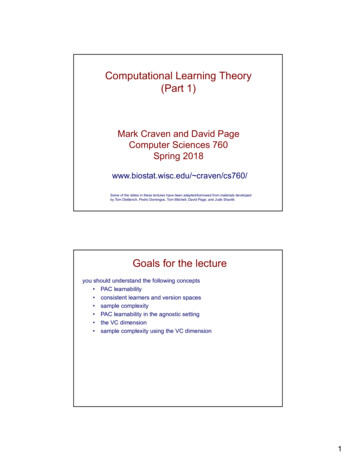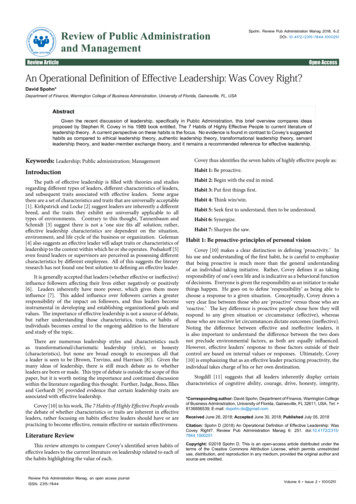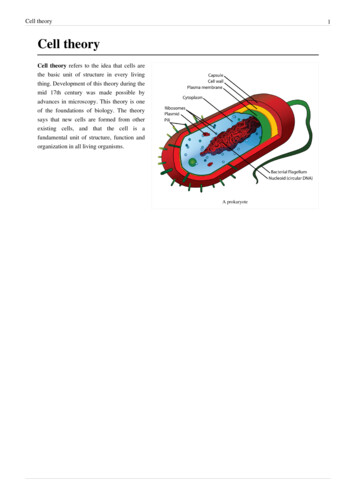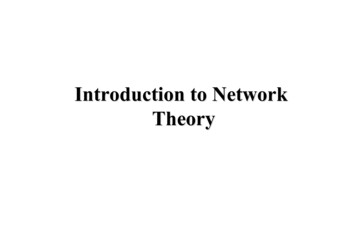
Transcription
Computational Learning Theory(Part 1)Mark Craven and David PageComputer Sciences 760Spring 2018www.biostat.wisc.edu/ craven/cs760/Some of the slides in these lectures have been adapted/borrowed from materials developedby Tom Dietterich, Pedro Domingos, Tom Mitchell, David Page, and Jude ShavlikGoals for the lectureyou should understand the following concepts PAC learnability consistent learners and version spaces sample complexity PAC learnability in the agnostic setting the VC dimension sample complexity using the VC dimension1
PAC learning Overfitting happens because training error is a poorestimate of generalization error Can we infer something about generalization errorfrom training error? Overfitting happens when the learner doesn’t seeenough training instances Can we estimate how many instances are enough?2
Learning setting #1instance space 𝒳c C - - set of instances 𝒳set of hypotheses (models) Hset of possible target concepts Cunknown probability distribution 𝒟 over instancesLearning setting #1 learner is given a set D of training instances 〈 x, c(x) 〉for some target concept c in C each instance x is drawn from distribution 𝒟 class label c(x) is provided for each x learner outputs hypothesis h modeling c3
True error of a hypothesisthe true error of hypothesis h refers to how often h is wrong on futureinstances drawn from 𝒟errorD (h) Px D [ c(x) h(x)]instance space 𝒳ch- - -Training error of a hypothesisthe training error of hypothesis h refers to how often h is wrong oninstances in the training set DerrorD (h) Px D [ c(x) h(x)] δ (c(x) h(x))x DDCan we bound error𝒟(h) in terms of errorD(h) ?4
Is approximately correctgood enough?To say that our learner L has learned a concept, should werequire error𝒟(h) 0 ?this is not realistic: unless we’ve seen every possible instance, there may be multiplehypotheses that are consistent with the training set there is some chance our training sample will be unrepresentativeProbably approximatelycorrect learning?Instead, we’ll require that the error of a learned hypothesis h is bounded by some constant ε the probability of the learner failing to learn an accurate hypothesisis bounded by a constant δ5
Probably Approximately Correct (PAC)learning [Valiant, CACM 1984] Consider a class C of possible target concepts defined over a set ofinstances 𝒳 of length n, and a learner L using hypothesis space H C is PAC learnable by L using H if, for allc Cdistributions 𝒟 over 𝒳ε such that 0 ε 0.5δ such that 0 δ 0.5learner L will, with probability at least (1-δ), output a hypothesis h Hsuch that error𝒟(h) ε in time that is polynomial in1/ε1/δnsize(c) PAC learning andconsistency Suppose we can find hypotheses that are consistent withm training instances. We can analyze PAC learnability by determining whether1. m grows polynomially in the relevant parameters2. the processing time per training example ispolynomial6
Version spaces A hypothesis h is consistent with a set of training examples D oftarget concept if and only if h(x) c(x) for each training example〈 x, c(x) 〉 in Dconsistent(h,D) ( x,c(x) D ) h(x) c(x) The version space VSH,D with respect to hypothesis space Hand training set D, is the subset of hypotheses from Hconsistent with all training examples in DVSH ,D {h H consistent(h,D)}Exhausting theversion space The version space VSH,D is ε-exhausted with respect to cand D if every hypothesis h VSH,D has true error ε( h VS ) errorH, DD(h) ε7
Exhausting the version space Suppose that every h in our version space VSH,D is consistentwith m training examplesThe probability that VSH,D is not ε-exhausted (i.e. that itcontains some hypotheses that are not accurate enough) H e ε mProof:(1 ε )mprobability that some hypothesis with error εis consistent with m training instancesk(1 ε )mthere might be k such hypothesesH (1 ε )mk is bounded by H H e ε m(1 ε ) e ε when 0 ε 1Sample complexity for finitehypothesis spaces[Blumer et al., Information Processing Letters 1987] we want to reduce this probability below δH e ε m δ solving for m we get1 1 m ln H ln δ ε log dependence on Hε has stronger influence than δ8
PAC analysis example:learning conjunctions of Boolean literals each instance has n Boolean featureslearned hypotheses are of the form Y X1 X 2 X 5How many training examples suffice to ensure that with prob 0.99,a consistent learner will return a hypothesis with error 0.05 ?there are 3n hypotheses (each variable can be present and unnegated,present and negated, or absent) in Hm for n 10, m 3121 1 ln ( 3n ) ln .01 .05 for n 100, m 2290PAC analysis example:learning conjunctions of Boolean literals we’ve shown that the sample complexity is polynomial in relevantparameters: 1/ε, 1/δ, n to prove that Boolean conjunctions are PAC learnable, need toalso show that we can find a consistent hypothesis in polynomialtime (the FIND-S algorithm in Mitchell, Chapter 2 does this)FIND-S:initialize h to the most specific hypothesis x1 x1 x2 x2 xn xnfor each positive training instance xremove from h any literal that is not satisfied by xoutput hypothesis h9
PAC analysis example:learning decision trees of depth 2 each instance has n Boolean featureslearned hypotheses are DTs of depth 2using only 2 variablesXiXj1 n H 16 2 # possible split choices Xj011n(n 1) 16 8n(n 1)2# possible leaf labelingsPAC analysis example:learning decision trees of depth 2 each instance has n Boolean featureslearned hypotheses are DTs of depth 2using only 2 variablesXiXj1Xj011How many training examples suffice to ensure that with prob 0.99,a consistent learner will return a hypothesis with error 0.05 ?m 1 1 ln ( 8n 2 8n ) ln .01 .05 for n 10, m 224for n 100, m 31810
PAC analysis example:K-term DNF is not PAC learnable each instance has n Boolean featureslearned hypotheses are of the form Y T1 T2 Tk whereeach Ti is a conjunction of n Boolean features or their negations H 3nk , so sample complexity is polynomial in the relevant parameters1 1 m nk ln(3) ln δ ε however, the computational complexity (time to find consistent h) is notpolynomial in m (e.g. graph 3-coloring, an NP-complete problem, can bereduced to learning 3-term DNF)What if the target concept is not inour hypothesis space? so far, we’ve been assuming that the target concept c is in ourhypothesis space; this is not a very realistic assumption agnostic learning setting don’t assume c H learner returns hypothesis h that makes fewest errors ontraining data11
Hoeffding bound we can approach the agnostic setting by using the Hoeffding boundlet 𝑍 𝑍% be a sequence of 𝑚 independent Bernoulli trials (e.g. coinflips), each with probability of success 𝐸 𝑍) 𝑝let 𝑆 𝑍 𝑍%𝑃 𝑆 𝑝 𝜀 𝑚 𝑒 45%67Agnostic PAC learning applying the Hoeffding bound to characterize the error rate of a givenhypothesis𝑃 𝑒𝑟𝑟𝑜𝑟𝒟 ℎ 𝑒𝑟𝑟𝑜𝑟D ℎ 𝜀 𝑒 45%6 7but our learner searches hypothesis space to find ℎ; 𝑃 𝑒𝑟𝑟𝑜𝑟𝒟 ℎ; 𝑒𝑟𝑟𝑜𝑟D ℎ; 𝜀 𝐻 𝑒 45%6 7solving for the sample complexity when this probability is limited to 𝛿𝑚 11𝑙𝑛 𝐻 𝑙𝑛2𝜀 5𝛿12
What if the hypothesis spaceis not finite? Q: If H is infinite (e.g. the class of perceptrons), what measure ofhypothesis-space complexity can we use in place of H ?A: the largest subset of 𝒳 for which H can guarantee zero trainingerror, regardless of the target function.this is known as the Vapnik-Chervonenkis dimension (VC-dimension)Shattering and the VC dimension a set of instances D is shattered by a hypothesis space H iff forevery dichotomy of D there is a hypothesis in H consistent withthis dichotomy the VC dimension of H is the size of the largest set of instancesthat is shattered by H13
An infinite hypothesis space with afinite VC dimensionconsider: H is set of lines in 2D (i.e. perceptrons in 2D feature space)can find an h consistent with 1instance no matter how it’s labeledcan find an h consistent with 2instances no matter labeling112An infinite hypothesis space with afinite VC dimensionconsider: H is set of lines in 2Dcan find an h consistent with 3instances no matter labelingcannot find an h consistent with 4instances for some labelings(assuming they’re not colinear)13 2- can shatter 3 instances, but not 4 the VC-dim(H) 3more generally, the VC-dim of hyperplanes in n dimensions n 114
VC dimension for finite hypothesis spacesfor finite H, VC-dim(H) log2 H Proof:suppose VC-dim(H) dfor d instances, 2d different labelings possibletherefore H must be able to represent 2d hypotheses2d H d VC-dim(H) log2 H Sample complexity and the VC dimension using VC-dim(H) as a measure of complexity of H, we can derivethe following bound [Blumer et al., JACM 1989]1 2 13 m 4 log 2 8VC-dim(H )log 2 ε ε δm grows log linear in ε (better than earlier bound)can be used for both finite and infinite hypothesis spaces15
Lower bound on sample complexity[Ehrenfeucht et al., Information & Computation 1989] there exists a distribution 𝒟 and target concept in C such that if thenumber of training instances given to L 1 1 VC-dim(C) 1 m max log , δ 32ε ε then with probability at least δ, L outputs h such that errorD(h) εComments on PAC learning PAC analysis formalizes the learning task and allows for nonperfect learning (indicated by ε and δ)finding a consistent hypothesis is sometimes easier for largerconcept classes e.g. although k-term DNF is not PAC learnable, the moregeneral class k-CNF isPAC analysis has been extended to explore a wide range of cases noisy training data learner allowed to ask queries restricted distributions (e.g. uniform) over 𝒟 etc.most analyses are worst casesample complexity bounds are generally not tight16
15 VC dimension for finite hypothesis spaces for finite H, VC-dim(H) log 2 H Proof: suppose VC-dim(H) dfor dinstances, 2ddifferent labelingspossible therefore Hmust be able to represent 2dhypotheses 2d H d VC-dim(H) log 2 H Sample complexity and the VC dimension using VC-dim(H)as a measure of complexity











